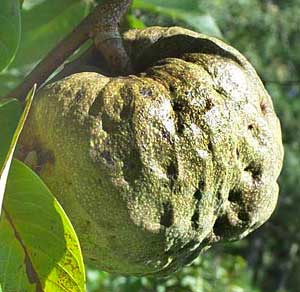

This sweet fruit containing abundant fair-sized seeds is known by its dimples. A native of the Peruvian Andes now it's planted in tropical and subtropical regions worldwide. Many races have been developed, producing fruits ranging from nearly globular to conical, some that are dimpled like the one at the right and others that are nearly smooth, and sometimes fruits can be covered with rounded, protruding bodies, or tubercles. Smooth-fruited races might be confused with Custard-Apples, except that Cherimoya leaves are velvety below while Custard-Apple leaves are practically hairless.
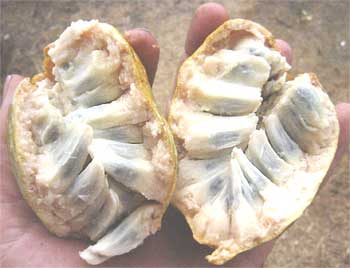
Ripe anonas, such as the one shown above, are yellowish and soft, full of hard seeds requiring lots of spitting. The very sweet flesh, however, is worth it. The plant producing this fruit is the small tree Annona cherimola, in the same plant family, the Custard-Apple Family, as North America's Pawpaws, whose fruits are somewhat similar.
 Avocados grow on large, handsome trees of
the Laurel Family, native to tropical America -- they are Persea americana.
Besides their use in guacamole and salads, Mexicans eat them out of the hand. First they
cut the fruit in half lengthwise, as shown in the picture. Then they remove the large,
spherical stone and cut from the stone a spoonlike sliver, which is flat on one face and
convex on the other. Then this spoon is used to scoop the waxy flesh from the tough,
leathery rind. In most mercados, the two main avocados are Criollo, a
smooth-skinned, usually small variety, and Cass, a wrinkle-skinned,
sometimes large one.
Avocados grow on large, handsome trees of
the Laurel Family, native to tropical America -- they are Persea americana.
Besides their use in guacamole and salads, Mexicans eat them out of the hand. First they
cut the fruit in half lengthwise, as shown in the picture. Then they remove the large,
spherical stone and cut from the stone a spoonlike sliver, which is flat on one face and
convex on the other. Then this spoon is used to scoop the waxy flesh from the tough,
leathery rind. In most mercados, the two main avocados are Criollo, a
smooth-skinned, usually small variety, and Cass, a wrinkle-skinned,
sometimes large one.
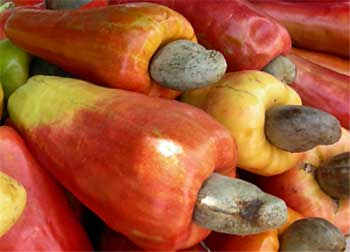
When we buy roasted cashew nuts, we're getting the kernels of the one-inch-long, kidney-shaped brown items at the right, which are the actual fruits. Technically speaking, the much larger red and yellow parts are not considered as part of the fruit, since they arise from vegetative parts, not from flowers. The larger red and yellow section is very tart and puckery, so much so that most people don't eat it. However, it can be mashed in water, sweetened, and prepared as a refreshing drink. Some people have reactions to the sap produced by the raw fruit. That's not surprising since Cashews are in the same family as Poison Ivy.
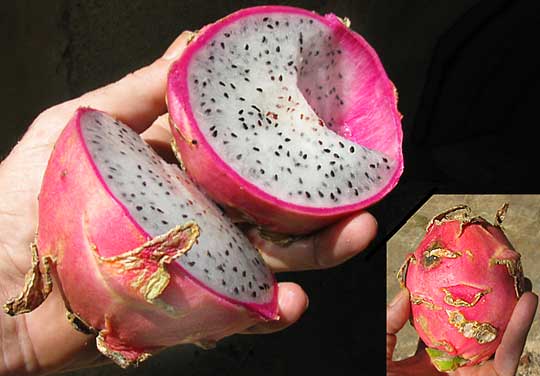
This is a cactus fruit, from the genus Hylocereus, one of the Night-blooming Cereuses. The fruits are fairly soft and easy to cut with a knife, and the somewhat sweet, lightly flavored, soft-cheese-textured flesh can be scooped out with a regular spoon. One fan says that their taste is "refreshing and palate cleansing." They can be cut in halves and frozen, then served as a sherbet substitute in their own shells. The cactus bearing the fruit produces fleshy stems reaching up to 30 feet long and may climb onto walls or over trees with their aerial roots. Sometimes you see pitaya plantations where supports are provided for the clambering stems to grow over.
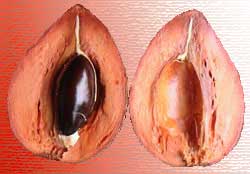 Some books call this fruit "Mammee
Apple" but it's so poorly known by Northerners that probably it's best for us
to use its Spanish name, mamey. Mamey is the brown fruit of a fair-size tropical-American
tree Calocarpum sapota, of the sapodilla family. This fruit may
actually be as good as chicozapote, and it has the right to be so, since it belongs
to the same family. Its soft, sugary flesh is dark brown to reddish, and melts in the
mouth. You know you have a mamey when it looks something like an Irish potato, has a
single large, dark-brown pit inside, and tastes like a succulent pastry. This is
really one of the queens of fruits.
Some books call this fruit "Mammee
Apple" but it's so poorly known by Northerners that probably it's best for us
to use its Spanish name, mamey. Mamey is the brown fruit of a fair-size tropical-American
tree Calocarpum sapota, of the sapodilla family. This fruit may
actually be as good as chicozapote, and it has the right to be so, since it belongs
to the same family. Its soft, sugary flesh is dark brown to reddish, and melts in the
mouth. You know you have a mamey when it looks something like an Irish potato, has a
single large, dark-brown pit inside, and tastes like a succulent pastry. This is
really one of the queens of fruits.
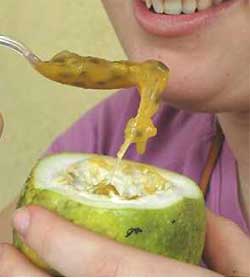 Passion-fruits, Passiflora
edulis, of the Passion Flower Family, are produced on vines and are
native to Brazil. The fruit's skin is hard but somewhat papery, and usually yellow-orange.
The small seeds, embedded in the soft, sweet pulp, are so unsubstantial that they can be
chewed and swallowed. Sweet drinks, high in vitamin C, are made from the pulp, but mostly
the fruits are just eaten raw. Unfortunately, passion doesn't result from eating the
fruit. The name derives from part of the anatomy of the plant's very pretty flower, which
reminds the religious-minded of The Cross, and Christ's Passion.
Passion-fruits, Passiflora
edulis, of the Passion Flower Family, are produced on vines and are
native to Brazil. The fruit's skin is hard but somewhat papery, and usually yellow-orange.
The small seeds, embedded in the soft, sweet pulp, are so unsubstantial that they can be
chewed and swallowed. Sweet drinks, high in vitamin C, are made from the pulp, but mostly
the fruits are just eaten raw. Unfortunately, passion doesn't result from eating the
fruit. The name derives from part of the anatomy of the plant's very pretty flower, which
reminds the religious-minded of The Cross, and Christ's Passion.
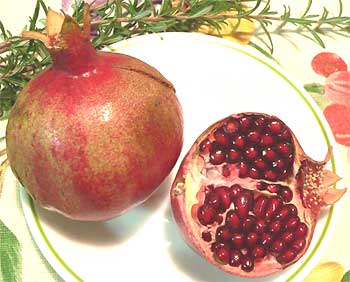
Pomegranates grow on small trees, Punica granatum, of the Pomegranate Family, and are native to southern Asia. Their skin bright red and leathery. Inside, numerous seeds are embedded in sweet, juicy sacs, and its those sacs which are edible. The seeds inside the sacs are soft enough to be chewed and swallowed, but most Northerners painstakingly and tediously spit them out. The fruit is eaten raw.
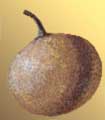 Sapodilla fruits are produced by a large,
pretty tree Achras zapota, of the Sapodilla Family. This is the
chicle tree from which white latex is taken for making chewing gum. Nowadays North
American chewing gum base is synthetic, but the persnickety Japanese still buy the natural
thing. This is surely Mexico's best-tasting native tropical fruit! Its flesh is
translucently yellowish-brown, and this is another fruit that should be asked for. Both
mameys and chicosapotes are seasonal, so you'll be lucky if you can find them!
Sapodilla fruits are produced by a large,
pretty tree Achras zapota, of the Sapodilla Family. This is the
chicle tree from which white latex is taken for making chewing gum. Nowadays North
American chewing gum base is synthetic, but the persnickety Japanese still buy the natural
thing. This is surely Mexico's best-tasting native tropical fruit! Its flesh is
translucently yellowish-brown, and this is another fruit that should be asked for. Both
mameys and chicosapotes are seasonal, so you'll be lucky if you can find them!